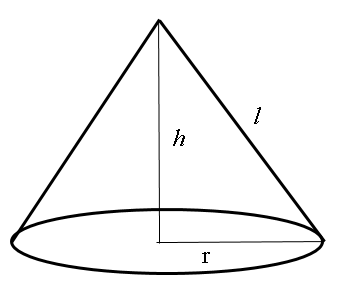
The perimeter of the base of a cone is 44 cm and the slant height is 25 cm. Find the curved surface of the cone.
Answer
512.1k+ views
Hint: To find the curved surface of the cone, we are given the perimeter of the base of a cone which is the same as the circumference of a circle, that is, $C=2\pi r$ . From this, we will get the value of r. Then, we have to substitute this value in the formula of curved surface area which is $\pi rl$ .
Complete step by step solution:
We have to find the curved surface of the cone. We are given that the perimeter of the base of the cone is 44cm. We know that the base of a cone is a circle.

We know that perimeter or circumference of a circle or cone is given by
$C=2\pi r$
where r is the radius of the cone.
$\Rightarrow 44=2\pi r$
Let us find the radius from the above equation.
$\Rightarrow r=\dfrac{44}{2\pi }$
We know that $\pi =\dfrac{22}{7}$ . Therefore, the above equation becomes
$\Rightarrow r=\dfrac{44}{2\times \dfrac{22}{7}}$
Let us cancel the common factor 22 from the RHS.
$\Rightarrow r=\dfrac{2}{2\times \dfrac{1}{7}}=\dfrac{2\times 7}{2}$
Let us cancel the common factor 2.
$\Rightarrow r=7\text{ cm}$
We know that curved surface area of a cone is given by
$\text{CSA of cone}=\pi rl$
where l is the slant height. We are given that $l=25\text{ cm}$ .
$\Rightarrow \text{CSA of cone}=\dfrac{22}{7}\times 7\times 25$
Let us cancel the common terms.
$\Rightarrow \text{CSA of cone}=22\times 25=550\text{ c}{{\text{m}}^{2}}$
Hence, the curved surface area of the given cone is $550\text{ c}{{\text{m}}^{2}}$ .
Note: Students must know the formulas of solids. Students must also know that the base of a cone is a circle. They must know the formula of the curved surface area (CSA) and total surface area (TSA) of a cone. They may get confused with the CSA and TSA of a cone. TSA of a cone is given as $\pi r\left( r+l \right)$ , where $l=\sqrt{{{r}^{2}}+{{h}^{2}}}$ , where h is the height of the cone.
Complete step by step solution:
We have to find the curved surface of the cone. We are given that the perimeter of the base of the cone is 44cm. We know that the base of a cone is a circle.

We know that perimeter or circumference of a circle or cone is given by
$C=2\pi r$
where r is the radius of the cone.
$\Rightarrow 44=2\pi r$
Let us find the radius from the above equation.
$\Rightarrow r=\dfrac{44}{2\pi }$
We know that $\pi =\dfrac{22}{7}$ . Therefore, the above equation becomes
$\Rightarrow r=\dfrac{44}{2\times \dfrac{22}{7}}$
Let us cancel the common factor 22 from the RHS.
$\Rightarrow r=\dfrac{2}{2\times \dfrac{1}{7}}=\dfrac{2\times 7}{2}$
Let us cancel the common factor 2.
$\Rightarrow r=7\text{ cm}$
We know that curved surface area of a cone is given by
$\text{CSA of cone}=\pi rl$
where l is the slant height. We are given that $l=25\text{ cm}$ .
$\Rightarrow \text{CSA of cone}=\dfrac{22}{7}\times 7\times 25$
Let us cancel the common terms.
$\Rightarrow \text{CSA of cone}=22\times 25=550\text{ c}{{\text{m}}^{2}}$
Hence, the curved surface area of the given cone is $550\text{ c}{{\text{m}}^{2}}$ .
Note: Students must know the formulas of solids. Students must also know that the base of a cone is a circle. They must know the formula of the curved surface area (CSA) and total surface area (TSA) of a cone. They may get confused with the CSA and TSA of a cone. TSA of a cone is given as $\pi r\left( r+l \right)$ , where $l=\sqrt{{{r}^{2}}+{{h}^{2}}}$ , where h is the height of the cone.
Recently Updated Pages
Master Class 12 Business Studies: Engaging Questions & Answers for Success

Master Class 12 Economics: Engaging Questions & Answers for Success

Master Class 12 English: Engaging Questions & Answers for Success

Master Class 12 Maths: Engaging Questions & Answers for Success

Master Class 12 Social Science: Engaging Questions & Answers for Success

Master Class 12 Chemistry: Engaging Questions & Answers for Success

Trending doubts
Who was the first woman to receive Bharat Ratna?

Write a letter to the principal requesting him to grant class 10 english CBSE

Why is there a time difference of about 5 hours between class 10 social science CBSE

What is the median of the first 10 natural numbers class 10 maths CBSE

The Equation xxx + 2 is Satisfied when x is Equal to Class 10 Maths

Discuss the main reasons for poverty in India




